About midway between Brandon and
Rivers, at the junction of Road 65 N and 117 W, there is a well-tended
cemetery with a cairn dedicated to the Roseville Congregation and the
first church in the area.
All congregations were anxious to build a church, but money was in
short supply. The solution was to cooperate, so four
denominations decided to share the facility. The Anglicans. Baptists,
Methodists and Congregationalists congregations each would supply the
Minister on one Sunday of each month.
They called it the Roseville Mission Hall, and the spirit of
cooperation went well beyond the sharing of the space. The funds and
collections were all pooled and managed by a joint treasurer. Most
parishioners joined heartily in the services whether it was their
particular denomination or not.
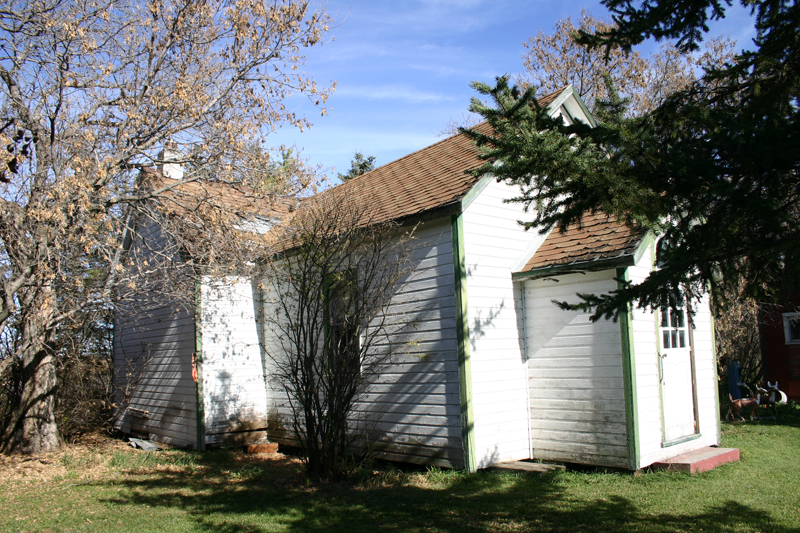
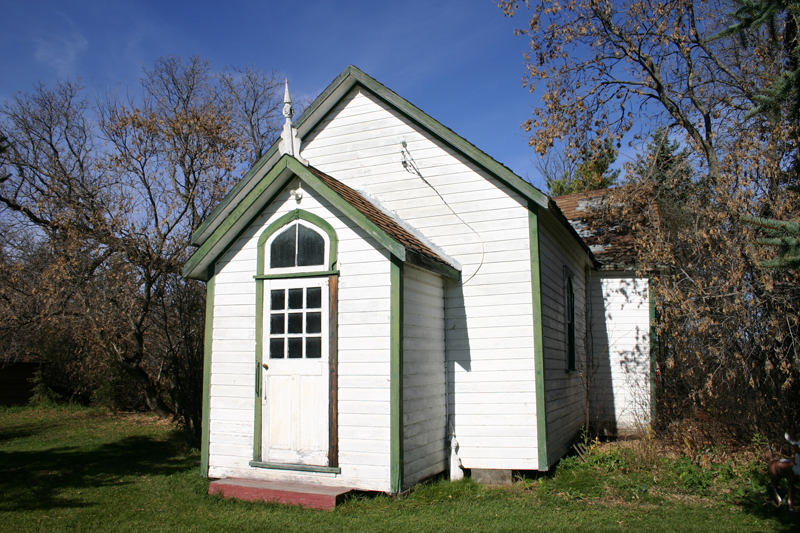
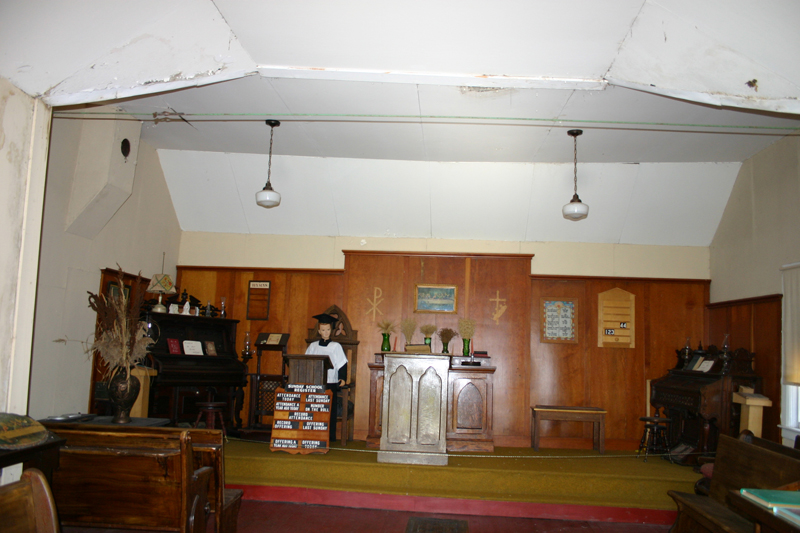
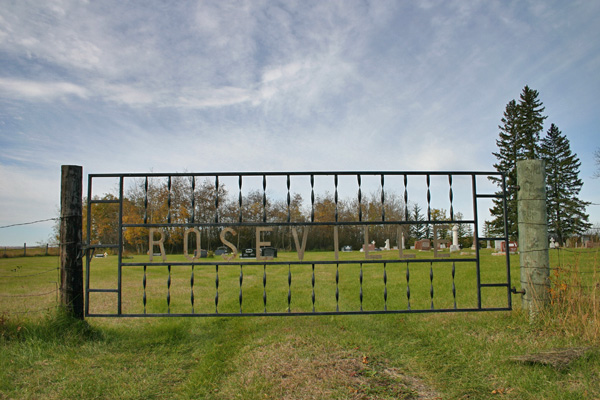
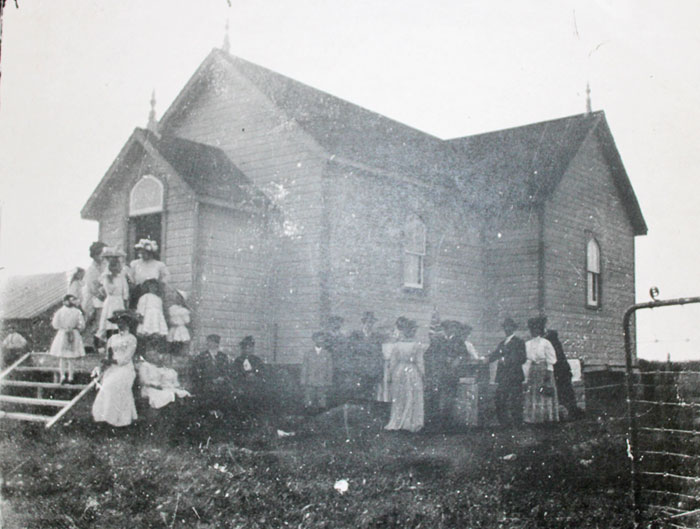




The Roseville Church by - Denise Bromley

This
summer as a result of participating in our Branch‘s cemetery
transcribing project, I re-visited the history of my community‘s little
country church. Roseville Church was 1 1/2 miles down the road from our
farm beside Roseville Cemetery. However, to preserve the building, it
is now located at the Chapman Museum just a short distance from its
original
location. This little church has given me a glimpse into what rural
life was like for my husband, Don,
while he was growing up. Inside there is the organ that
his grandmother used to pump out the music on Sunday morning,
Attendance Roll charts hanging on the wall listing himself, his
siblings, cousins and friends with stars strung out behind their names,
hymn books along with many other items relating to the church and the
people who once attended the services.
After
taking some photographs of the church, of memorabilia and
reminiscing with Lois Allen, I dug out my "From Generations to
Generations" history book as compiled by the Committee and Members of
the Kirkham Bridge Women‘s Institute. The following, with permission is
their article about Rosedale Church.
The
English Church which had been holding services in this new
settlement a few years previous to the building of Roseville Church,
was first represented by the Reverend Shepherd, minister at Rapid City,
and it is something worthy of note that the English Church has given a
steady and continuous service up to the present time.
For
the Baptist, Mr. Westwood, a local preacher, was the first to
occupy the pulpit. When the Baptist College was instituted at Brandon,
the students used to fill the vacancies, one of whom in later years was
the Reverend K. Stone, a preacher in the First Baptist Church,. This
denomination, at one time, held their baptismal service at the ―Ford‖
four miles straight west of Roseville, on the Little Saskatchewan
River. It attracted many spectators; some even came the night before to
set up camp so that they would be on hand early to get a choice seat on
the bank, to witness the event.
A
Methodist, Reverend Davies, is supposed to have held the very first
service in the church on March 30th, 1884. One Methodist preacher
stands out in the memory of one of the first church-goers. He could
quote scripture ‘ad lib‘, his ordinary conversation was full of
Scriptural texts and sayings, and his invocations were something
extraordinary. He would begin very softly then get to forte, gradually
working up to crescendo, until at last one could almost hear him a mile
away, hammering at the Throne of Grace.
The
Congregationalists were first supplied by the Y. M. C. A. of
Brandon, who gave some very interesting and lively meetings. Reverend
Mason ministered for several years, as did Mr. H. Cater, then Mayor of
Brandon.
About
1915, the Methodists withdrew their minister from Roseville as he
had a large charge which took in Forrest; Wesley and Bethel. The
Congregational Church in Brandon, from where this denomination had
drawn its supply of ministers was closed, so this left only the
Anglican and Baptist denominations. For some time the Baptists carried
on services but when the divinity course was no longer offered at
Brandon College, it was found too difficult to secure someone to take
services, so they too dropped out. Then for the next twenty-five years
the Anglican and Union services alternated until gradually for various
reasons the Union services were discontinued.
Through
the years several changes have been made to the Church, all by
voluntary labour. An addition, 16 x 16 was built in 1896, which
increased the seating capacity considerably. In 1909 a basement was
dug, then in 1926 a new foundation was placed under it, and a new
furnace installed. It was repainted inside and out and another carpet
purchased for the platform. In 1942 the interior was lined with gyproc
and painted. The original seats and pulpit were made and donated by Mr.
James Varcoe; but in 1952 these seats were sent to the mission at Snow
Lake and Roseville fell heir to the pews from the disused Church at
Wheatland. An altar was added in 1944, and a Booker Furnace some time
later. In 1953 the building was wired for electricity. The building has
served many purposes—for Sunday School classes, concerts (Christmas and
otherwise), meeting place for the Circle of Kings Daughter‘s, Ladies
Aid, Women‘s Auxiliary and Junior Auxiliary, and sometimes for picnic
suppers, 25th, 50th, 70th and 100th Anniversaries have been celebrated.
What
a wealth of
recollections these two words bring to the minds of
those whose lives were coincident with the beginning and building of
that Church, memories sweet and bitter, memories of joys and sorrows,
memories of dear ones ―loved long since and lost awhile,‖ memories that
are ever hallowed by the fleeting wings of Time. One cannot tell the
story of Roseville Church without mentioning some of the incidents
leading up to its beginning and building which has meant so much to the
people of this district, and is held in such affectionate remembrance
by all those who were members from its earliest history.
During
January, 1882, Mr. William Peirson, visiting the Varcoes in
Portage la Prairie, remarked to Mrs. Varcoe (then principal of Portage
Collegiate), ―We are looking forward to the time when you settle on
your homestead, so that you can take a Bible Class for our boys on the
Sabbath‖. When she arrived on her farm Mr. Peirson called again, and
urged the formation of a Bible Class. Accordingly on Easter Sunday,
March 25th, 1883, at the invitation of Mr. and Mrs. James Varcoe eight
young people gathered at their home to form a Class and to study God‘s
word. Later on it was urged that the ̳heads of the families
should enjoy the privileges of Christian Worship‘, so through the
summer of that year services were held in four different homes
(Peirson‘s, Caporn‘s, Varcoe‘s and probably Cousin‘s), hymns were sung,
with a word of prayer. It was found that at the end of a year, an
average of 21 persons had been present each Sunday.

It
should be emphasized here, that the formation and origin of
Roseville Mission Hall (as it was then called) was greatly due to the
efforts and sincere sense of Christian duty and service held by the
James Varcoes, who have long since passed to the ̳Great Beyond‘.
In the spring of 1884, when the need of a place of worship was apparent
to everyone, two friends went around collecting and canvassing for the
necessary funds. Everyone visited, gave, or promised willingly sums of
money, and also the needed labour for building this first church in
Daly Municipality.
Mr.
Varcoe
donated two acres of land in the northeast corner of his
farm on 8-11- 20 for a church site and burial ground. Thirteen teams
hauled the building materials from Brandon, free of charge, then work
commenced. A structure 16 x 24 was soon erected ―for the people had a
mind to work‖ and the first service was held on Easter Sunday, April
13th, 1884. It might here be stated that owing to the smallness of any
one denomination, it was thought better to make it a Union Church and
to pool the funds under one treasurer. Each denomination — Baptist,
Episcopal, Methodist and Congregationalist, held its own service one
Sunday of the each month, which on the whole worked very successfully,
as everyone joined heartily in the services whether it was their
particular denomination or not.
In
connection with this it might be said ̳in passing‘ that while
those inside the Church were singing ―Peace, perfect Peace‖, with every
sign of concord and unity, there was often disunity outside. As is well
known, in country places there is always a large canine population. So
it was in those days. Every farmer was the possessor of two or three
dogs and no doubt the latter did not see why they could not follow a
team or buggy on Sundays as well as week days, so there generally was a
goodly array of Church- going dogs.
Often
when the congregation was singing a hymn, some dogs more
musically inclined than the rest would join in, which did not
contribute to the melody, but which not doubt, they thought a howling
success. At other times just as the minister was beginning his
̳thirdly‘, a dogmatic discussion would start up outside by some dogs
belong perhaps to a Baptist or Episcopalian member, others would join
in and it would end up in a ̳free- for-all‘. This was very
disturbing and tantalizing to the younger portion of the congregation
inside, particularly when they could hear some of the boys at the back
slipping out to see the fun. Sometimes an elder of the Church would go
out ostensibly to stop the noise, but it was thought he really went to
see that his dogs didn‘t get the worst of the discussion. Roseville, in
those days, boasted a choir and choir master. One choir leader of note
was Mr. George Mann who was a gold medalist, having sung before Queen
Victoria. He proved to be master of any situation, when for instance on
the Sunday morning that Mrs. Fred Caporn‘s big collie dog followed her
to Church and as she took her place in the choir the dog took his place
under her seat. While the first hymn was being sung the dog began to
howl. Mr. Mann turned when (he) heard the sound and said, "The soprano
is out".
1959
saw Roseville celebrate its 75th Anniversary. The Anglican
Ministers from Rivers continued to conduct services, but finally,
because of changing times, it was felt that it would be better to
amalgamate with St. James Anglican Church in Rivers. A once a year
service and picnic continued to be held at Roseville.
In
1979 the Roseville congregation decided to close Roseville Church,
and the building was donated and moved to the Albert Chapman Museum.
The annual service and picnic have continued to be held on the Museum
Grounds.
In
1983 a special service took place, to unveil and dedicate a cairn
which now stands in Roseville Cemetery, where close by for so many
years the community had gathered to worship. Centennial year, 1984,
also was celebrated with thankfulness for 100 years of worship,
fellowship, and neighborliness in Roseville Community. Indeed,
Roseville Church has remained a Beacon Light, casting its rays of
Christian influence and blessings into the hearts and lives of all who
lived within the radius of its beam.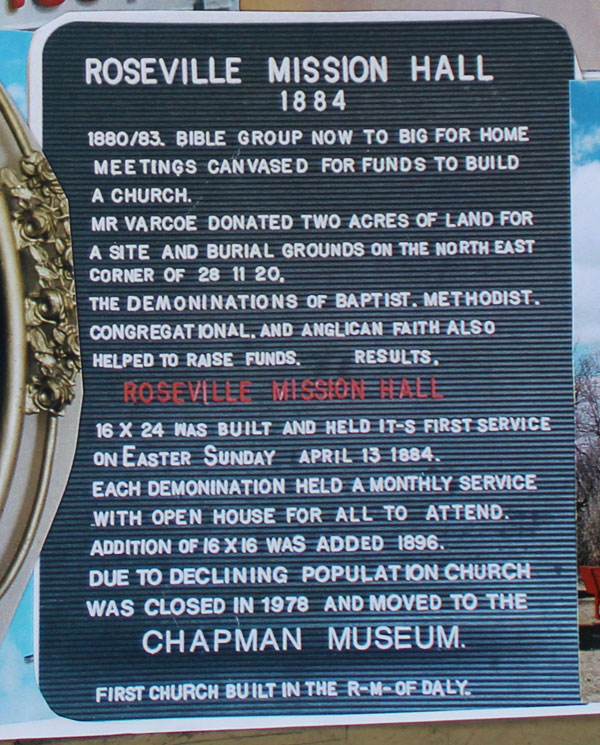

|